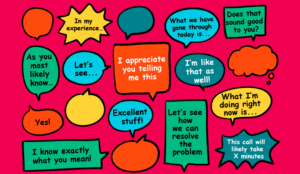You have a bad agent in your team. Now what?
Megan Jones, Editor at Call Centre Helper, interviewed Kim Ellis, Chief Learning Architect at Go Ginger Learning Solutions, and Rob Clarke, Director and Co-Founder of Elev-8 Performance, to find out what the experts say you can do to turn a negative situation into a positive – without showing an agent the door.
Step 1 – Why Are They a ‘Bad’ Agent?
‘Bad’ is a very subjective term and there are many reasons why an agent might not be performing at their best, including:
- Emotional baggage
- Lack of confidence
- Lack of training
- They don’t care or feel invested in the job
- Recruitment issues (Were they really the right person for the role?)
The biggest advice is to not make any sweeping assumptions, says Kim Ellis:

“Let’s face it, most people don’t go to work to deliberately do a bad job, so don’t make assumptions on what’s behind the issue.
“It’s about finding out what is going on with that one person, dealing with them, and understanding their personal motivators.
“It can be really difficult to unpack because it all depends on what the issue is.
“It could be an outside factor that you’ve got no control over, or that they lack confidence and need additional training, so it’s all down to the team leader finding out what’s going on – first and foremost.”
However, as Rob Clarke continues, it’s always good to rule out any problems at home too:
“It could be that the agent is carrying lots of emotional baggage from their personal life that is weighing on their mind and impacting their performance.
“A good initial conversation could be ‘I’ve noticed some changes in your approach to work lately and I’d love to understand what’s been going on. I’m here to support you. Is there anything you’d like to talk about?’”
Step 2 – Don’t Jump Straight to a Personal Improvement Plan (PIP)
Whatever may be behind the issue, don’t just leave the situation to fester until the agent’s next quarterly review. Instead, get started right away, as it’s far better to understand the situation as soon as possible.
Above all else, try and be positive and optimistic!
Above all else, try and be positive and optimistic! That way you can encourage the agent to do a good job, working together to find better ways of doing things.
Don’t jump straight into a formal Personal Improvement Plan (PIP) involving the HR team, because it will very likely be a self-fulfilling prophecy – winding up with a negative outcome. If you take that path, you immediately lose goodwill.
Step 3 – Understand Which Solution Would Work Best
The next step is to choose an approach which will help move the situation forward in the best possible way.
The Radical Candour Model Can Help You Reset Your Management Style
There’s a model you can use to help understand your management style called the Radical Candour model, says Rob Clarke:

“The Radical Candour framework, developed by Kim Scott, is a matrix with two axes –’Care Personally’ and ‘Challenge Directly’. ‘Care Personally’ refers to the extent to which you show you care about the other person as a human being, whilst ‘Challenge Directly’ steers towards more direct conversations, challenging them to improve.
“The four quadrants of the matrix are:
- Radical Candour (Care Personally + Challenge Directly) – This is the ideal quadrant, where you care about the person and are not hesitant to challenge them directly. This leads to open, honest, and respectful communication.
- Obnoxious Aggression (Challenge Directly + Don’t Care Personally) – Here, you challenge but don’t show you care. It often comes across as abrasive or uncaring.
- Ruinous Empathy (Care Personally + Don’t Challenge Directly) – In this quadrant, you care about the person but fail to challenge them directly, which can lead to unaddressed issues and lack of growth.
- Manipulative Insincerity (Don’t Care Personally + Don’t Challenge Directly) – This is where neither care nor direct challenges are present. It can lead to passive-aggressive behaviour, politicking, and non-constructive feedback.
“Once you have a firm understanding of what type of manager you are and how you could improve your approach, you can choose the best way forward.”
You could also:
Plan Some Top-Up Training
The quickest and easiest problem to address is a skills issue.
If you are lucky enough for it to be this simple, there’s things you can try – including more side-by-side support sessions, top-up training, and more, to help boost their confidence.
Here are some ideas for quick wins for training agents:
See If the Agent Could Be Motivated by Time or Money
Sometimes there isn’t a reason that people aren’t good at the job, they just don’t care, says Kim Ellis:

“Perhaps it’s an easy payday. They might have smashed your interview, but they get in there and think ‘I hate this place, but the money’s good, so there’s no point leaving’.
“If you got someone who’s just there because of the money, nothing’s really going to change that, but you can work with it.
“Why not try adding monetary incentives to help boost their performance? Or if they value their time, run a time incentive or early finish? It can all make a difference in the short term.”
Find Out If the Problem Actually Started During the Recruitment Process
It can also help to look beyond the individual to wider business issues – especially if this is becoming a recurring issue.
It may very well be that there’s a problem with your recruitment and onboarding process – and that some accountability may lie with the leadership team.
If the interview process is selling them a dream that doesn’t match reality, their first day is going to be the start of ongoing issues – and it comes down to the ability for leaders to set really clear expectations from day one.
For ideas on how to improve your recruitment and onboarding process, read these articles:
Step 4 – Use Feedback Techniques to Encourage Positive Change
When you’ve got an agent struggling, it would be good to balance praise for the things they’re doing right with constructive feedback on improving the area that needs improvement – it’s not about skirting the tough conversations, but it is about demonstrating that you do care.
This approach can go a long way in turning a negative situation around.
Balance praise for the things they’re doing right with constructive feedback on improving the area that needs improvement.
If you’re concerned about how to get started, you could try one of these ‘tried and tested’ feedback techniques, as Rob Clarke explains:
The Shared Meaning Tool
The shared meaning tool is about having a two-way dialogue, ensuring mutual understanding, and finding common ground between you.
For example, saying: “I know you value customer experience, so I was curious to understand why, when I was listening some of your calls, I noticed a lack of empathy on some of the conversations. I’d love to explore with you what might be driving that”.
Phrases such as “I’m curious” and “let’s explore” bring the agent into the challenge and the solution in a way that feels like you’re trying to collaborate.
The IDEA Model
There’s also a feedback model called ‘the idea model’ that stands for:
- Intent
- Describe
- Explore
- Action
For example, if you’re talking about a low conversion rate in sales. You might say: “My INTENT in having this conversation with you is to help you because I know you’re keen to achieve your end-of-year bonus to support your house purchase, and [DESCRIBE] what I observed earlier was that you shut down an opportunity with a client maybe a bit early, and I’d like to EXPLORE what happened in that conversation with you, so next time you could try something different for a different outcome [ACTION].
Step 5 – Keep in Touch and See It Through
Above all, once you’ve begun this process, you’ve got to see it through and invest time in helping the agent to understand their journey and progress, so it can help to:
Set Clear Goals
Provide support and resources, have a mentoring coaching, and be really clear around goal setting and monitoring progress – without the formality of setting up a PIP (Personal Improvement Plan).

Grab a Weekly Coffee
“I get the sense that maybe we need to stay a bit closer over the next six weeks. How about we grab coffee once a week. How does that sound?” is a great way to keep a closer eye on an agent as they (hopefully) start to improve – without it being formalized as 1-to-1 or HR meetings.
Be Positive
Do whatever it takes to keep the conversation positive.
Saying things like “I want you to succeed, as I think on a good day you add a lot of value, but we do need to understand where and when you aren’t at your best, so we can work together to improve on that.”
Be Realistic About When It’s Best to Set Them Free
Unfortunately, not every situation will have a positive outcome, and at some point, you will need to switch away from softer, more strategic tactics if things don’t improve.
There’s also a case for managing people out of the business or department if it just isn’t the right role for them, and they’ll probably thank you later. But you won’t know until you start the process.
If you are looking for more information on managing problematic employees, read these articles next:
- How to Identify and Manage Toxic Employees
- How to Combat Quiet Quitting in the Call Centre
- The 5 Danger Signs of Complacency in Your Contact Centre
- 10 Red Flags to Watch Out for With New Hires
Author: Megan Jones
Published On: 31st Jan 2024 - Last modified: 12th Feb 2024
Read more about - Call Centre Management, Editor's Picks, Kim Ellis, Performance Management, Rob Clarke, Team Management, Top Story






































